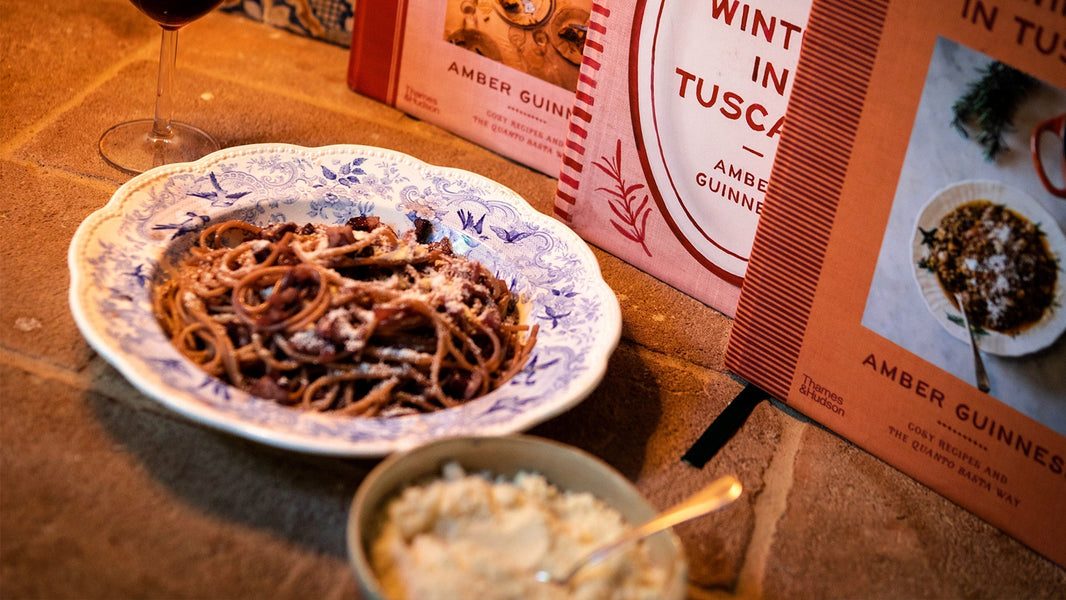© Roberta Paolucci
Author and food writer Amber Guinness has spent her life surrounded by Italian food. Born in London and raised in Tuscany, she studied history and Italian literature at university and has worked as a cook in both London and Italy. In her two previous books – A House Party in Tuscany and Italian Coastal – she distilled the art of authentic Italian home cooking, whether from a farmhouse in the Tuscan landscape to a sun-drenched island on the Tyrrhenian Sea.
In her new book Winter in Tuscany, Amber Guinness leans into Tuscany’s cosy autumnal and wintry flavours and the quanto basta way. In this extract, she sheds light on the Tuscan pantry, sharing the staples and essentials to be found in any home across the region.

© Valentina Solfrini 2025
After the fall of the Roman empire and the invasions of the barbarians, regional Italian cooking started to emerge as people weren’t part of one Empire as they had been under the Romans. Venetian cooking, for instance, became strikingly different from Tuscan as they traded with the Orient, which influenced their ingredients and flavours, whereas Tuscan cuisine always stayed very much tied to its own local produce. Here are some of the ingredients you’ll typically find in a Tuscan kitchen, and throughout the recipes in this book.
Aglione
This is a type of elephant garlic grown in the Val di Chiana, between Arezzo, Cortona and Chiusure. It’s huge, but has a much milder flavour than regular garlic, meaning that it is very easy to digest and doesn’t lead to the dreaded ‘garlic breath’ – which is why it is also known as l’aglio del bacio (‘kissing garlic’). When crushed and very gently cooked in oil, it almost froths and melts into its own sauce, which when paired with tinned or fresh tomatoes makes one of the most wonderful accompaniments for pici (thick Tuscan noodles made from flour and water), known as pici all’aglione. You can substitute normal garlic for aglione by using half the amount called for in the recipe, but you’ll need to remove the central green shoot – known as the germ – to make it a little milder.

© Valentina Solfrini 2025
[...]
Cannellini Beans
These magical beans are a key ingredient for many of Tuscany’s most classic dishes, such as ribollita, and make the perfect accompaniment to Tuscany’s simply grilled meats in the form of fagioli al fiasco (cannellini beans cooked very gently overnight in a glass beaker with garlic and herbs), and fagioli all’uccelletto (beans in tomato sauce). When whizzed up, they give soups a velvety creaminess which means you don’t have to resort to butter or indeed cream to make a steaming bowl of soup on a cold winter’s night feel cosy and warming – surely better for our health, and great for anyone who follows a vegan diet. I always have a few tins or jars of precooked cannellini beans in my cupboard to stir through a simple vegetable stew, to make a creamy soup base for a spelt soup or pasta e fagioli. As I love fagioli al fiasco but am often in a hurry, I have come up with a recipe for Garlicky rosemary cannellini beans using tinned beans to give the same satisfying effect.
[...]
Cavolo Nero
Probably the most emblematic of Tuscan vegetables, cavolo nero – or ‘black cabbage’ – is a brassica with no head, instead growing long, elegant dark green leaves, similar to kale. The leaves feel a little rubbery, look a bit like dinosaur skin and are water repellent. Growing from autumn and into the new year, they are at their best after the first frost, which tenderises the leaves. They need cooking to become edible, and to prepare them, you simply pull along the tough white stem to strip away the more tender leaves, discarding the stalk. Cavolo nero is one of my favourite vegetables, and I love it stirred through soups, blanched and stir-fried with garlic and chilli or whizzed into a pesto to dress pasta.

© Valentina Solfrini 2025
[...]
Flours
Italians have a whole variety of flours that are milled to different degrees of fineness. The finest is ‘00’, which is typically used to make cakes, pastries and fresh pasta as it yields a very soft texture. The next one up is ‘0’, which is still fairly fine. Both of these have a low protein content and can be substituted with plain or all-purpose flour for the recipes in this book.
Lentils and Spelt
Spelt is high in fibre, and rich in iron, magnesium and potassium, and in Italy has always been felt to hold particular health benefits such as lowering cholesterol and being good for the digestive system. It keeps well once cooked, ready to be stirred through a thick, hearty soup, or in the warmer months turned into insalata di farro, a cold salad in which the spelt is seasoned and mixed with lots of grilled vegetables. It can also be used as a more nutrition-packed substitute for rice in ‘speltotto’. Lentils have always been popular in this historically poor area, being so affordable and very high in protein. Tradition dictates that they must be eaten on New Year’s Eve to bring wealth and prosperity, with pork sausages, pig’s trotter or pork loin the usual accompaniment.

© Valentina Solfrini 2025
Olive Oil
Cold-pressed extra virgin olive oil is one of the great joys of living in Tuscany. Its unctuous green colour and peppery taste are one of the highlights of November when the olives are harvested and the olio nuovo (new oil) is pressed. Using very good cold-extracted olive oil is perhaps the easiest way to elevate the simplest salad to the sublime, but as it is expensive, don’t use it for cooking. Good olive oil is expensive; there isn’t really a way around that. Keep it for that filo d’olio crudo (drizzle of raw oil) at the end of assembling a dish or to douse your toast in. For cooking, I’m not too fussy and I’m happy with a more economical ordinary olive oil from the supermarket, so long as it’s labelled as being ‘single origin’. It’s important to keep a beady eye on labels to make sure you aren’t buying stuff that is laced with seed oils. Avoid those on which the small print says it is a blend of olive oils from different countries, as that is when they usually add lower-grade oils to bulk it out and make it cheaper.
Pancetta
Salt-cured pork belly, pancetta is tasty and goes delightfully crispy when fried. It adds a fabulous salty, meaty element to many pasta dishes, particularly when paired with green vegetables. I always use unsmoked pancetta, as I find the flavour of smoked pancetta too overpowering, but this is down to personal taste. You can buy pancetta as ready-cut cubetti, or lardons, or in flat round slices, which you can chop into little pieces. If you have a good deli, you can buy pancetta in thick slices to dice your own lardons – or even better, ask for guanciale, salt-cured pig cheek (the essential ingredient of any true carbonara) to add even more salty fat to your dish.

From left to right: © Valentina Solfrini 2025 / © Valentina Solfrini 2025
[...]
Pecorino
Southern Tuscany is famous for its pecorino, as there is plenty of grazing for the sheep whose milk will be turned into this delicious cheese. Our local flock often get lost and bumble through our garden at Arniano, and we are alerted to their presence by the jingle-jangle of the bells around their necks. Pecorino di Pienza, from Tuscany’s cheese-making capital of Pienza in the Val d’Orcia, is famed for its tangy, nutty flavour and generally comes in three forms of maturity. Fresco, hardly matured at all, is a white super-mild cheese that is fabulous with tender young broad beans in spring, or bruleed under sugar; it can be substituted with emmental or a mild cheddar. Semi-stagionato is the orange-rinded, more flavoursome pecorino that I serve as part of an aperitivo and it is great with a glass of wine or Prosecco. Stagionato is a very nutty, brittle, mature cheese which works beautifully with something sweet, such as a slice of pear or a drizzle of truffle-infused honey. A semi-stagionato or stagionato works wonderfully as a substitute for parmesan for grating over your pasta or ‘speltotto’. At Casalinga, a family-run trattoria in Florence, they use these instead of parmesan in their pestos.
[... ]
Rosemary
Rosemary is possibly the most used herb in Tuscan cooking. It accompanies most roasts, is scattered over potatoes ready for the oven, is added to focaccia dough and is generally considered one of the quickest ways to inject flavour into most dishes. It’s a hardy herb that grows in abundance all over Tuscany under even the most exacting circumstances, and we have bushes and bushes of it at home at Arniano where the soil is predominantly clay, which is famous for being impossible to grow anything in. When I lived in London I used to keep buying little packets of rosemary sprigs and realised what a ridiculous waste of money this was. A little rosemary plant is not much more expensive than a few sprigs in plastic and yields so much more. This plant now happily lives on my windowsill, ready for its smaller sprigs to be snipped off for cooking, and has the added benefit of giving off a lovely scent. I never use dried rosemary. Whenever a recipe in this book calls for rosemary, it is always fresh.

© Roberta Paolucci
[...]
Stracchino
Stracchino is a creamy soft white cheese made of cow’s milk. It’s sold in little plastic tubs, as its consistency is essentially similar to panna cotta, and it has a pleasant tangy acidity that pairs well with most flavours. It’s absolutely wonderful spread on toast and topped with the new season’s extra virgin olive oil in November, or with the best of the summer’s tomatoes in August. Sadly, it can be difficult to find outside of Italy, which is why, whenever I put it on the breakfast or lunch table for guests, people exclaim at its deliciousness and ask why on earth they have never heard of it. Stracchino is often used as part of an aperitivo or antipasto here in Tuscany, and is also mixed with sausage meat to make the ultimate wine bar (enoteca) menu staple: grilled sausage and stracchino crostone. If you can’t find stracchino, a ripe young brie is a good substitute, as is cream cheese, or even taleggio, though this has a much more dominant flavour, and none has the lovely acidic backnote of stracchino, so will be more rich.
Words by Amber Guinness
Pre-order your copy of the upcoming Winter in Tuscany, publishing this autumn.










